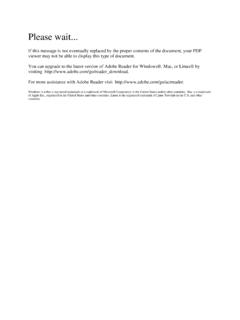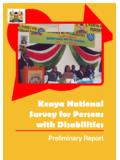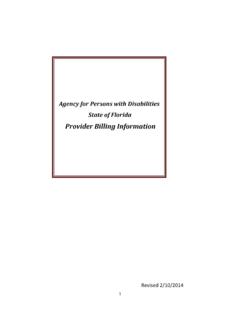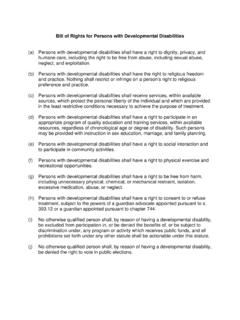Transcription of Incheon Strategy to “Make the Right Real” for …
1 Incheon Strategy to Make the Right real for persons with disabilities in asia and the PacificUnited Nations PublicationCopyright United Nations 2012 All rights reservedPrinted in BangkokST/ESCAP/2648 Disclaimer Reproduction of material in this publication for sale or other commercial purposes, including publicity and advertising, is prohibited without the written permission of the copyright holders. Applications for such permission, with a statement of purpose and extent of the reproduction, should be addressed to the Director, Social Development Division, United Nations Economic and Social Commission for asia and the Pacific at United Nations Economic and Social Commission for asia and the Pacific Bangkok, November 2012ipersons with disabilities live in asia and the PacificiiAs we launch the new Asian and Pacific Decade of persons with disabilities , 2013 2022, let us focus on addressing the remaining challenges.
2 By adopting and implementing the Incheon Strategy , you can help to ensure a disability-inclusive post-2015 development agenda Ban Ki-moon Secretary-General United NationsiiiivESCAP is the regional development arm of the United Nations and serves as the main economic and social development centre for the United Nations in asia and the Pacific. Its mandate is to foster cooperation among its 53 members and 9 associate members. ESCAP provides the strategic regional link between global and country-level programmes and issues. It supports Governments of the ESCAP region in consolidating regional positions and advocates regional approaches to meeting unique Asian and Pacific socioeconomic challenges in a globalizing world. The ESCAP secretariat is located in Bangkok. For more information, please visit our website at < >.Explanatory note on ESCAPvESCAP Members and Associate MembersMembersAfghanistanArmenia Australia Azerbaijan Bangladesh Bhutan Brunei Darussalam CambodiaChina Democratic People s Republic of Korea Fiji FranceGeorgia India Indonesia Iran (Islamic Republic of) Japan KazakhstanKiribati Kyrgyzstan Lao People s Democratic RepublicMalaysia Maldives Marshall Islands Micronesia (Federated States of)
3 Mongolia Myanmar Nauru NepalNetherlandsNew ZealandPakistan PalauPapua New Guinea PhilippinesRepublic of KoreaRussian Federation Samoa SingaporeSolomon Islands Sri LankaTajikistanThailand Timor-LesteTonga TurkeyTurkmenistan Tuvalu United Kingdom of Great Britain and Northern Ireland United States of AmericaUzbekistanVanuatu Viet Nam Associate MembersAmerican SamoaCook Islands French PolynesiaGuamHong Kong, China Macao, China New Caledonia NiueNorthern Mariana Islands1 Introduction 2 Ministerial Declaration on the Asian and Pacific Decade of persons with disabilities , 2013 2022 3 Incheon Strategy to Make the Right real for persons with disabilities in asia and the Pacific 11A. Background 14B. Key principles and policy direction 15C. Incheon goals and targets 19D. Modalities for effective implementation: national, subregional and regional levels 371. National level 372. Subregional level 393.
4 Regional level 39 Annex Terms of reference of the Working Group on the Asian and Pacific Decade of persons with disabilities 42 Contents2 Governments of the ESCAP region gathered in Incheon , Republic of Korea, from 29 October to 2 November 2012 to chart the course of the new Asian and Pacific Decade of persons with disabilities for the period 2013 to 2022. They were joined by representatives of civil society organizations, including organizations of and for persons with disabilities . Also in attendance were representatives of intergovernmental organizations, development coopera-tion agencies and the United Nations High-level Intergovernmental Meeting on the Final Review of the Implementation of the Asian and Pacific Decade of Disabled persons , 2003 2012, was organized by ESCAP and hosted by the Government of the Republic of Korea. The Meeting marked the conclusion of the second Asian and Pacific Decade of Disabled persons , 2003 2012, and launched the new Governments at the High-level Intergovernmental Meeting adopted the Ministerial Declaration on the Asian and Pacific Decade of persons with disabilities , 2013 2022, and the Incheon Strategy to Make the Right real for persons with disabilities in asia and the Incheon Strategy provides the Asian and Pacific region, and the world, with the first set of regionally agreed disability-inclusive development goals.
5 Developed over more than two years of consultations with governments and civil society stakeholders, the Incheon Strategy comprises 10 goals, 27 targets and 62 indicators. The Incheon Strategy builds on the Convention on the Rights of persons with disabilities and the Biwako Millennium Framework for Action and Biwako Plus Five towards an Inclusive, Barrier-free and Rights-based Society for persons with disabilities in asia and the Incheon Strategy will enable the Asian and Pacific region to track progress towards improving the quality of life, and the fulfilment of the rights, of the region s 650 million persons with disabilities , most of whom live in poverty. The ESCAP secretariat is mandated to report every three years until the end of the Decade in 2022, on progress in the implementation of the Ministerial Declaration and the Incheon , the ministers and representatives of members and associate members of the United Nations Economic and Social Commission for asia and the Pacific (ESCAP)
6 Assembled at the High-level Intergovernmental Meeting on the Final Review of the Implementation of the Asian and Pacific Decade of Disabled persons , 2003 2012, held at Incheon , Republic of Korea, from 29 October to 2 November 2012,Recalling General Assembly resolution 37/52 of 3 December 1982, in which the Assembly adopted the World Programme of Action con-cerning Disabled persons , 1 and resolution 48/96 of 20 December 1993, in which the Assembly adopted the Standard Rules on the Equalization of Opportunities for persons with disabilities , in which persons with disabilities are recognized as both development agents and beneficiaries in all aspects of development,Also recalling General Assembly resolution 61/106 of 13 December 2006, in which the Assembly adopted the Convention on the Rights of persons with disabilities and its Optional Protocol, which entered into force on 3 May 2008,Further recalling General Assembly resolution 65/1 of 22 September 2010, entitled Keeping the promise.
7 United to achieve the Millennium Development Goals , in which the Assembly, inter alia, recognized that policies and actions must focus on the poor and those living in the most vulnerable situations, including persons with disabilities , so that they benefit from progress towards achieving the Millennium Development Goals,Welcoming the decision of the General Assembly to hold the High-level Meeting on the Realization of the Millennium Development Goals and other Internationally Agreed Development Goals for persons with disabilities , at the level of heads of State and Government, on 23 September 2013, with the overarching theme The way forward: a disability-inclusive development agenda towards 2015 and beyond , 21 A/37/351 and , annex, sect. VIII, recommendation 1 (IV).2 See General Assembly resolution 66/124 of 19 December Declaration on the Asian and Pacific Decade of persons with disabilities , 2013 20224 Recalling General Assembly resolution 66/290 of 10 September 2012, which stipulates an agreed common understanding of human security, which, inter alia, states that all individuals, in particular vul-nerable people, are entitled to freedom from fear and freedom from want, with an equal opportunity to enjoy all their rights and fully develop their human potential,Also recalling Commission resolution 48/3 of 23 April 1992 on the Asian and Pacific Decade of Disabled persons , 1993 2002, in which the Commission proclaimed the first such regional decade in the world,Further recalling Commission resolution 58/4 of 22 May 2002 on promoting an inclusive.
8 Barrier-free and rights-based society for people with disabilities in the Asian and Pacific region in the twenty-first century, in which the Commission proclaimed the extension of the Asian and Pacific Decade of Disabled persons for another decade, from 2003 to 2012,Recalling Commission resolution 59/3 of 4 September 2003 on the regional implementation of the Biwako Millennium Framework for Action towards an Inclusive, Barrier-free and Rights-based Society for persons with disabilities in asia and the Pacific during the Decade of Disabled persons , 2003 2012, in which the Commission, inter alia, requested members and associate members to support the imple-mentation of the Biwako Millennium Framework for Action,Also recalling Commission resolution 64/8 of 30 April 2008 on regional implementation of the Biwako Millennium Framework for Action and Biwako Plus Five towards an Inclusive, Barrier-free and Rights-based Society for persons with disabilities in asia and the Pacific, in which the Commission mandated the convening of a high-level intergovernmental meeting to review the implementation of the Biwako Millennium Framework for Action and Biwako Plus Five in 2012, the concluding year of the Asian and Pacific Decade of Disabled persons , 2003 2012,5 Further recalling Commission resolution 66/11 of 19 May 2010 on regional preparations for the High-level Intergovernmental Meeting on the Final Review of the Implementation of the Asian and Pacific Decade of Disabled persons , 2003 2012.
9 In which the Commission encouraged the participation of all key stakeholders, including organ-izations of persons with disabilities from asia and the Pacific, in the preparatory process leading up to the High-level Intergovernmental Meeting,Recalling Commission resolution 68/7 of 23 May 2012, in which the Commission proclaimed the Asian and Pacific Decade of persons with disabilities , 2013 2022, and urged all members and associate members to participate actively in the High-level Intergovernmental Meeting and to consider and adopt a strategic framework to guide the implementation of the Decade that is based on the general prin-ciples and obligations stipulated in the Convention on the Rights of persons with disabilities ,Noting that the World Report on Disability estimates that 15 per cent of the population experience some form of disability, which in the Asian and Pacific region equates to 650 million persons with disabil-ities, with 80 per cent living in developing countries, 3 Welcoming the progress that has been achieved over the course of two Asian and Pacific Decades, spanning the period 1993 to 2012, by ESCAP members and associate members in establishing the foun-dation for a rights-based approach, with a focus on the dignity of persons with disabilities , to inclusive development, particularly through policy and institutional commitments, as well as new strides in legislation and empowerment,Noting with appreciation the contributions of civil society, par-ticularly organizations of and for persons with disabilities , to the progress achieved, including through continuous awareness-raising 3 World Health Organization/World Bank, World Report on Disability (Geneva.)
10 World Health Organization, 2011), the rights of persons with diverse disabilities , innovation of good practices, and engagement in policy dialogue,Bearing in mind that Pacific Leaders at the Forty-first Pacific Islands Forum, held in Port Vila, reaffirmed, through their Communiqu of 5 August 2010, 4 their strong support for the Pacific Regional Strategy on Disability 2010 2015 5 to protect and promote the rights of persons with disabilities , to provide a framework for coordination in building a disability-inclusive Pacific, and to strengthen stakeholder commit-ment towards the implementation of the Convention on the Rights of persons with disabilities and other disability-related human rights instruments,Noting with appreciation the Bali Declaration on the Enhancement of the Role and Participation of persons with disabilities in the ASEAN Community, 6 adopted on 17 November 2011 by the Association of Southeast Asian Nations (ASEAN)






